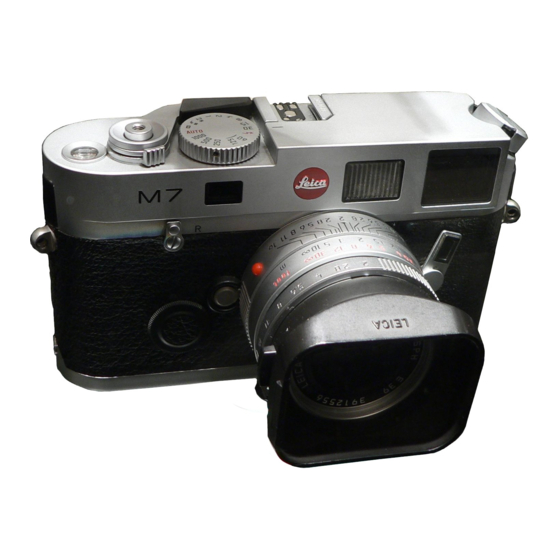
Leica M7 Supplementary Manual
Leica m7: supplementary guide
Hide thumbs
Also See for M7:
- Brochure (76 pages) ,
- Instructions manual (70 pages) ,
- Technical data (2 pages)
Advertisement
New 6-bit coding of Leica M system lenses for image optimization in connection with
the planned digital camera model
Leica Camera AG, Solms will be giving the lenses of the Leica rangefinder system a new code
on the bayonet ring in future to enable the planned digital Leica M camera to recognize the
lens type. The information on the lens that is being used helps the camera to optimize image
st
quality. All lenses leaving the factory from July 1
, 2006 onwards will have the new coding,
although they can still be fully used with the current analog cameras LEICA MP and LEICA M7
as well as classic models built after 1954. Lenses in the current range as well as many earlier
models can be retrofitted at the cost of the owner to benefit from the image optimization in
the camera. The lenses are compatible with the planned digital M camera even without
retrofitting, except that the additional features cannot be used.
The lens coding is called '6-bit coding' because six fields in the bayonet ring are marked in
black or white to represent a number from 1 to 64 in binary code. The planned digital M
camera reads this information optically and can identify the lens on the basis of this code.
Apart from the improvement in image quality, this information is also written into the EXIF
image file.
"On account of their legendary quality, nearly all Leica M lenses are ideal for digital use.
However, the new 6-bit coding also uses the performance reserves in the image processing of
the camera to give our customers the excellent image result they expect from Leica," says
Rainer Bültert, product manager for the M system at Leica Camera AG.
Lenses bought in the past will be converted at the request of the customer for 81.51 € plus VAT
at the Customer Service of Leica Camera AG in Solms or the Leica agencies of other countries.
Many of the lenses made from 1963 onwards can be converted. A list of such models is
available on the following pages or from the Leica Info-Service (Tel. 06442/208-111). The
only lens in the current range that will not be given a 6-bit coding is the LEICA APO-TELYT-M
135 mm f/3.4. It is not codable later, either, as its extension factor of 1.33 makes it
unsuitable for use on the planned digital M camera. The launch of the digital Leica
rangefinder camera is planned for the second half of 2006.
Page 1 of 3
Advertisement
Table of Contents

Subscribe to Our Youtube Channel
Summary of Contents for Leica M7
- Page 1 , 2006 onwards will have the new coding, although they can still be fully used with the current analog cameras LEICA MP and LEICA M7 as well as classic models built after 1954. Lenses in the current range as well as many earlier models can be retrofitted at the cost of the owner to benefit from the image optimization in the camera.
- Page 2 List of present lenses that can be updated: Name Elmarit-M 21mm f/2.8 ASPH. Elmarit-M 24mm f/2.8 ASPH. Summicron-M 28mm f/2 ASPH. Tri-Elmar-M 1:4/28-35-50mm f/4 ASPH. Summilux-M 35mm f/1.4 ASPH. Summicron-M 35mm f/2 ASPH. Summicron-M 35mm f/2 ASPH. Noctilux-M 50mm f/1.0 Summilux-M 50mm f/1.4 ASPH.
- Page 3 Besides those presently available, even lenses that were discontinued quite a while ago can be updated (see list below). Since Leica Camera AG regards system compatibility as a vital virtue, many lenses introduced as long ago as 1963 can be updated.















Need help?
Do you have a question about the M7 and is the answer not in the manual?
Questions and answers